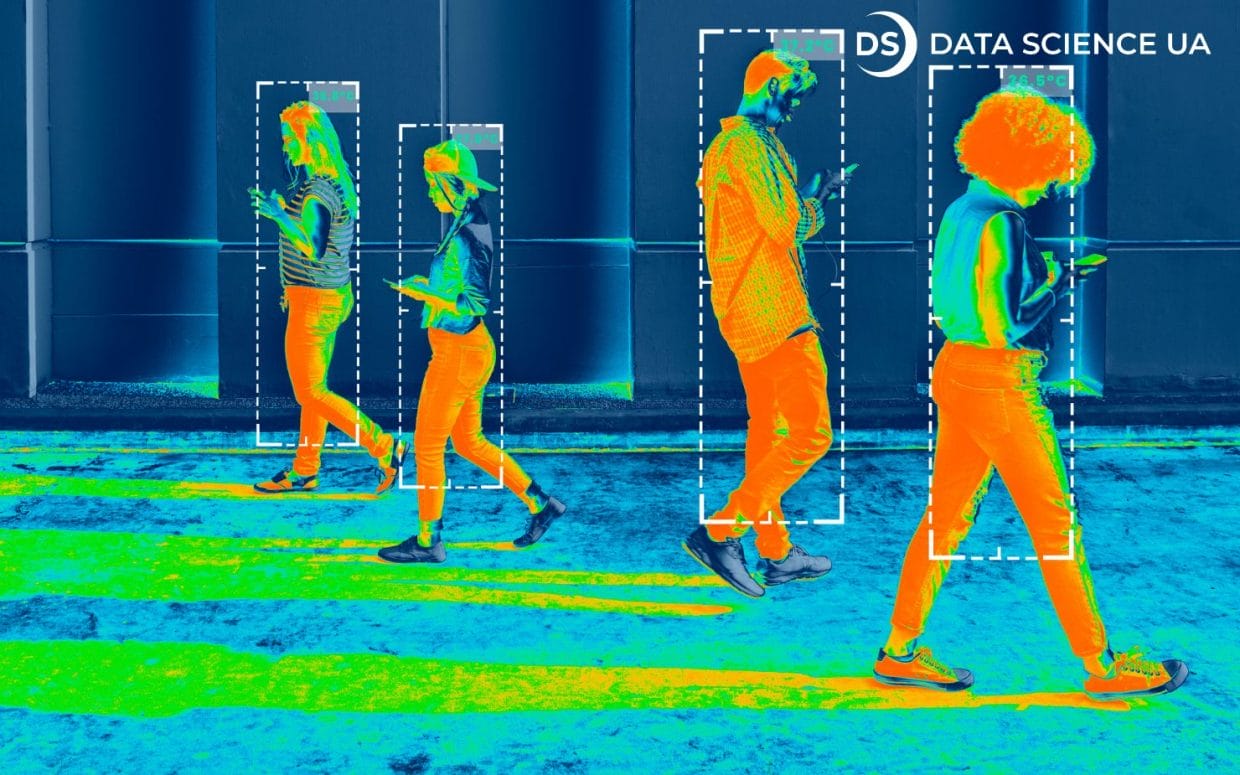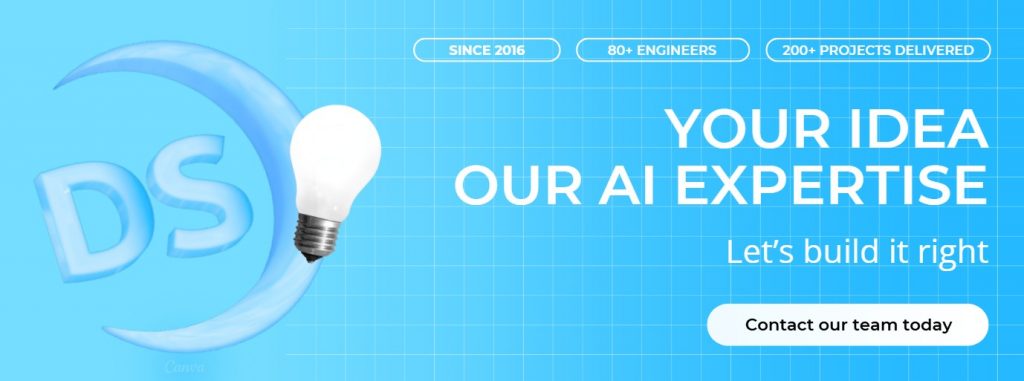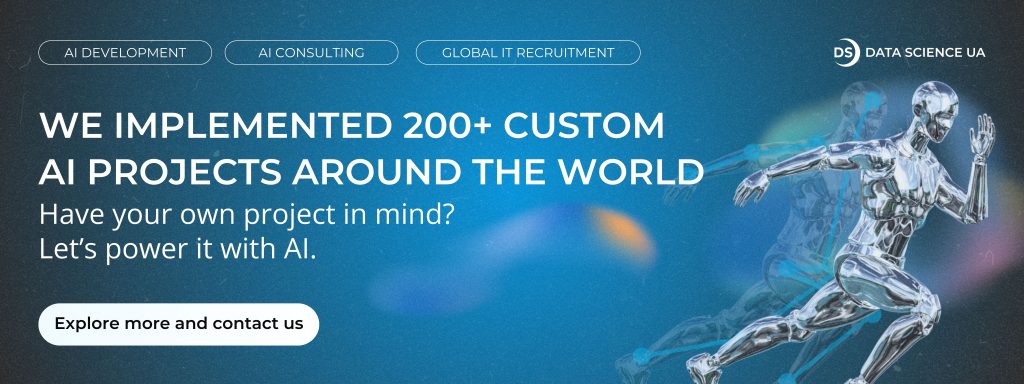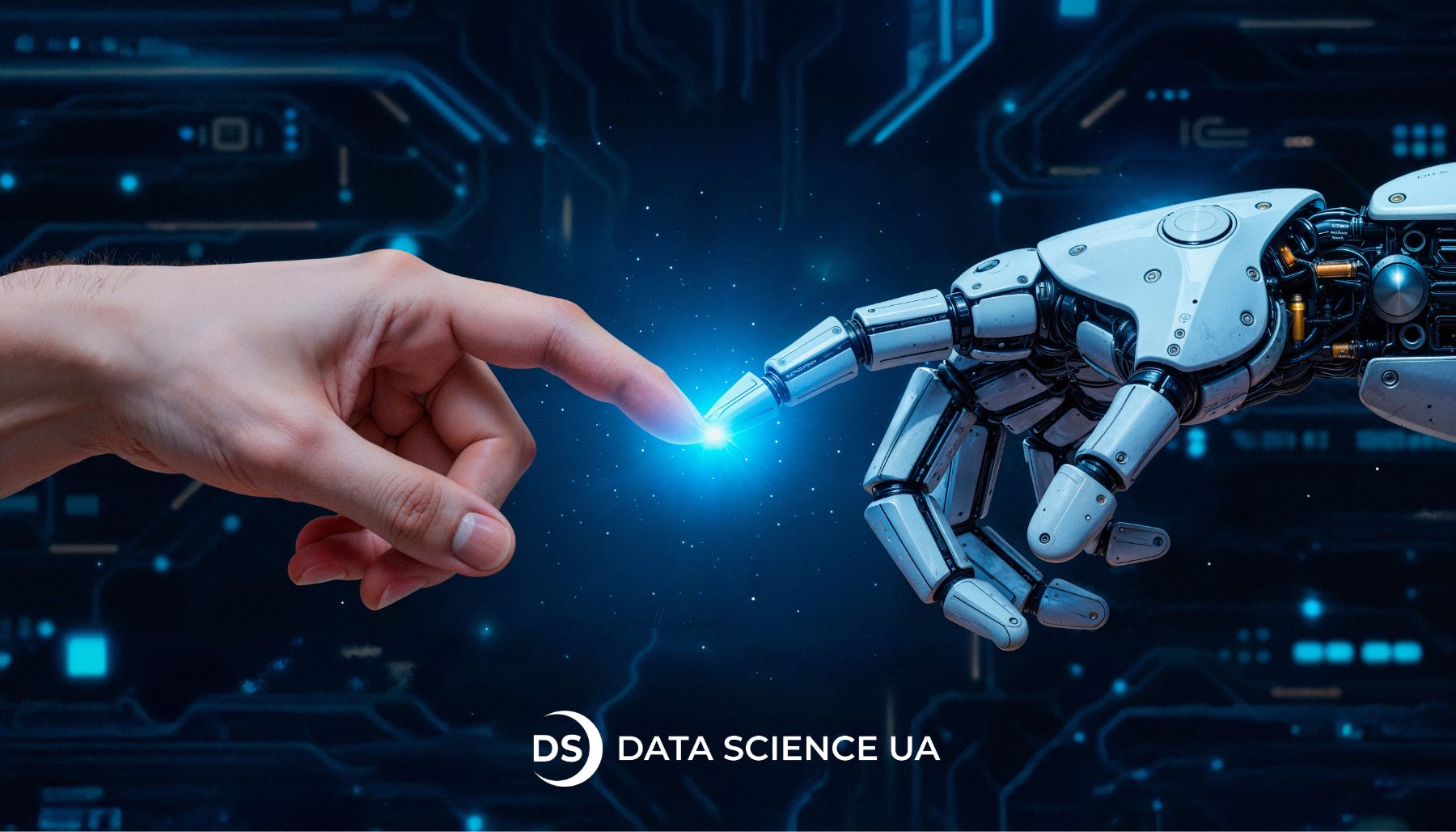Semantic segmentation vs instance segmentation: Key differences and use cases
Understanding semantic segmentation: what is it?
What does a camera on a factory line do when it “sees” a defect on a product? How does a drone’s navigation system tell the difference between a highway and a pedestrian area? The answer lies in a technology called semantic segmentation.
Put simply, semantic segmentation helps the machine “map out” an image by object class. For example, in a street photo, it will label the sky as the sky, the road as the road, and so on. And it does this for every object of the same category at once. Cars, people, buildings – each gets its own color-coded mask.
The nuance here is that semantic segmentation doesn’t distinguish between individual objects of the same class. So, if there are three cars in the image, the algorithm won’t differentiate between them – it simply labels them all as “car”. What happens next depends on the specific task.
But why is semantic segmentation being actively adopted in business processes? What kinds of problems does it solve, where does it truly add value, and what kind of return can companies expect? What to choose: instance segmentation vs semantic segmentation? Let’s explore and start with the semantic one.
Key benefits of semantic segmentation
-
Improved accuracy of environmental perception
Semantic segmentation allows algorithms to not just “see” an abstract image, but to differentiate exactly what and where each object is. Instead of “That’s a cityscape”, we get “That’s the road, a pedestrian is walking, and a tree growing nearby”. This is a crucial factor for the automotive industry, and in autonomous vehicles like Tesla’s and Waymo’s, semantic segmentation already enables systems to distinguish between curbs, traffic lights, and other road objects, thereby reducing the risk of driving errors.
-
Saving time and resources on manual marking
Instead of completely manual work, there is quick quality control.
The numbers are impressive: time costs are reduced by 10-15 times. A company that previously employed a staff of 30 laborers now only needs 3-5 experts. Salary savings amount to 70-80%, and the quality of tagging even improves – the algorithm does not tire and applies uniform criteria to all images.
If your company needs to process tens of thousands of images every month, tagging automation becomes not just a convenience but a necessity for survival in a competitive environment.
-
Improving the quality of personalization
In retail and marketing, images of products and faces can be classified into categories for more accurate content display.
Zalando uses semantic segmentation to automatically recognize and tag clothing in photos in order to recommend similar products to customers.
-
Automation of quality control processes
In manufacturing, models quickly identify defects in product images, saving money and reducing the defect rate.
Siemens uses semantic segmentation in factories to assess the integrity of components on assembly lines in real time.
Contact our team today to implement AI in your business!
Limitations of semantic segmentation
-
No distinction between instances of the same class
Semantic segmentation identifies where the “cars” are in an image, but it won’t differentiate which car is which.
It can lead to errors in object counting or interaction, which is crucial in logistics and safety systems.
-
High sensitivity to data quality
The model may “confuse” sand with asphalt or grass with bushes if the training data was not diverse enough.
In the agricultural sector, where satellite images are used to assess the condition of fields, semantic segmentation can make classification errors if the photo has shadows or poor lighting.
-
Limited applicability in real-time
Although models are faster than they were 5–10 years ago, there are still performance issues on mobile and edge devices.
In augmented reality, apps like Snapchat or TikTok use segmentation, but they can “lag” on weak devices or in low-light conditions.
-
Dependence on annotated datasets
To train an accurate model, thousands of carefully labeled images are needed. It’s expensive and time-consuming.
In healthcare, where a precise definition of tumor boundaries is important, a mistake in marking at an early stage can ruin the entire model.
Applications of semantic segmentation
Semantic segmentation often becomes part of larger computer vision solutions. In such cases, businesses turn to professional image recognition software development services, which allow for a customized solution tailored to specific tasks and data.
With the ability to accurately define the boundaries of objects and classify each pixel of an image, this approach helps businesses automate and improve critical processes.
| Industry | Application | |
| Automobile | Visual recognition of lanes, pedestrians, and road signs for autonomous driving | |
| Medicine | Marking up MRI/CT scans, highlighting tumors and anomalies | |
| Agriculture | Analyzing crop conditions with drones, identifying problem areas | |
| Retail and Logistics | Tracking goods on shelves, automating accounting, and inventory |
Understanding instance segmentation: What is it?
Imagine a video surveillance camera in a shopping center. Semantic segmentation will tell you: “There are people in the frame, there are shopping carts, there are merchandise stands”. But it won’t answer the main business questions: exactly how many customers are in the store? Which ones are moving towards the exit, and which ones just came in? Which shopping cart belongs to which customer?
Instance segmentation solves these tasks. It determines that there are people in the image, but also clearly separates each person as a separate object. Two customers standing next to each other at the checkout counter are no longer merged into one spot — the system understands where one person ends and another begins.
This technology adds layers to the “What is this object?” question, revealing how many objects are in the frame and where exactly each of them is located.
For businesses, this means moving from a general understanding of the situation to precise data that can be used to make specific decisions.
But what other benefits does this technology offer?
Key benefits of instance segmentation
Accurate counting of objects in real-time
How many customers entered the store in the last hour? How many cars passed through the intersection? How many parts came off the assembly line? Previously, people with notebooks or complex sensors were needed to obtain such data. Instance segmentation turns a regular camera into an accurate counter.
The system doesn’t just record the quantity – it tracks each object individually. If a person leaves the frame and then returns, the algorithm will not count them as a new visitor. Such accuracy is critically important for retail when analyzing customer traffic or for transportation companies when monitoring road congestion.
Tracking the movement and behavior of objects
Each designated object receives a unique identifier, allowing its path to be traced over time. The customer entered the store, stopped at the shoe display, went to the checkout, and returned to the clothing shelves – the system will remember the entire route.
This information is gold for business analytics. Retailers understand which areas of the store are most attractive to customers, where people linger the longest, and which products are most frequently picked up but not purchased. The result is an optimized store layout and increased sales.
Detailed analysis of interactions between objects
Instance segmentation sees not only individual objects, but also how they interact with each other. On the production line, the system tracks how parts move between machines, where congestion occurs, and which operations take longer than planned.
In the security field, this capability opens up new horizons. The system can identify suspicious behavior: a person standing too long near an ATM, a car driving in the wrong lane, a group of people gathering in an inappropriate place.
Let’s power your company with AI!
Limitations of instance segmentation
High demands on computing resources
Instance segmentation requires significantly more computing power than semantic segmentation. While semantic segmentation can work on a regular office computer, instance segmentation requires powerful graphics cards or specialized processors.
This affects the project’s cost. The company has to either buy expensive equipment or rent cloud capacity, which increases operating expenses. For small and medium-sized businesses, such costs can be prohibitive, especially during the initial implementation phase.
Difficulty in working with overlapping objects
When objects partially overlap, even advanced algorithms can make mistakes. The person in the crowd is half hidden behind another person’s back – the system may not recognize them as a separate object.
This problem is especially relevant for tasks where high object density is the norm: counting people at concerts or rallies, analyzing traffic during rush hour, or inventorying goods in crowded warehouses.
Reduced performance with more objects
The more objects in the frame, the slower the system works. If 5-10 objects enter the camera’s field of view, processing occurs quickly. But when there are 50-100 objects, the time it takes to analyze one frame can increase several times.
For real-time applications, it becomes a critical issue. The airport’s video surveillance system must process streams from dozens of cameras simultaneously, analyzing hundreds of people in each frame. A delay in processing can cause important events to be missed.
The need for large amounts of labeled data
Training a high-quality instance segmentation model requires thousands, and sometimes tens of thousands, of labeled images. Moreover, the markup must be extremely accurate – you need to not only indicate the boundaries of each object, but also correctly separate objects that touch or overlap each other.
Creating such a dataset is an expensive and time-consuming process. A team of experts can spend months preparing a training sample. For specialized tasks, there are no ready-made datasets, so the company has to create them from scratch.
Applications of instance segmentation
Autonomous vehicles and smart logistics
On the roads, where passengers’ and pedestrians’ safety is critically important, every little detail matters. A self-driving car must not just understand that there are other cars ahead – it needs to know exactly how many there are, where each one is, and where it is going. Instance segmentation turns the chaos of city traffic into a structured picture.
The system tracks each car, motorcycle, pedestrian, and cyclist as a separate object. When three cars are driving in a dense stream, the algorithm clearly separates their boundaries and predicts the trajectory of each car. The result is safe maneuvering even in difficult road conditions.
Logistics companies use this technology to optimize warehouse operations. The robotic forklifts accurately count the number of pallets, track the movement of each box, and automatically update inventory levels. Amazon and other e-commerce giants are already saving millions of dollars thanks to this automation.
Medical diagnostics and analysis of biomaterials
In medicine, it is often critically important not just to find a pathology, but to accurately determine its size and the number of foci. When analyzing X-ray images of the lungs, the system isolates each suspicious spot, measures its area, and tracks changes over time.
Hematologists use instance segmentation to count blood cells. Instead of manually counting under a microscope, thousands of cells can be analyzed in minutes. The system distinguishes erythrocytes, leukocytes, and platelets, determines their shape and size, and identifies abnormal cells.
The technology is especially valuable in oncology. When analyzing biopsies, the algorithm identifies each cancer cell individually, which helps to accurately determine the stage of the disease and choose the optimal treatment strategy.
Retail and consumer behavior analytics
Instance segmentation allows you to track the path of each visitor from the entrance to the checkout, understand which displays they stop at, and how much time they spend in different areas of the store.
The system counts conversions with accuracy down to individual customers. 100 people entered, 23 bought something – conversion 23%. But more valuable information is hidden in the details: which products do customers pick up more often, but put back on the shelf? In which areas of the store do people linger the longest?
Large retail chains use this data to optimize the layout of their stores. Popular items are placed deep in the store so that customers see more other products on their way. The result was a 15-20% increase in the average check.
Security and video surveillance systems
Traditional video surveillance cameras record what’s happening, but they don’t analyze it. Instance segmentation turns passive observation into an active threat warning system.
At airports, the system tracks each passenger individually. If a person stays in one area for too long, leaves their luggage unattended, or moves against the general flow, the system immediately alerts the security service.
Banks use technology to prevent fraud. The system analyzes people’s behavior near ATMs: if a person stands too long near the device without performing any operations, or their movements look suspicious, additional control is activated.
Companies that need professional computer vision development services can significantly speed up the implementation of such solutions by obtaining ready-made expertise instead of creating a team from scratch.
Instance segmentation vs Semantic segmentation: Key differences
| Characteristics | Semantic Segmentation | Instance Segmentation |
| Main task | Classifying each pixel into categories | Identification and separation of individual objects within each category |
| Processing result | A color map with zones of different classes | Numbered masks for each individual object |
| Object differentiation | Doesn’t differentiate between individual instances (all cars = one red spot) | Clearly separates each object (auto №1, №2, №3) |
| Processing speed | High (30-60 FPS on average equipment) | Average (10-25 FPS, depends on the number of objects) |
| Computational requirements | Low-medium | High (requires powerful GPUs) |
| Memory consumption | Moderate | High (increases with the number of objects) |
| Learning difficulty | Relatively simple | Complex (accurate boundaries of objects are required) |
| Training sample size | Thousands images | Thousands of labeled images |
| Accuracy during overlap | Low (objects merge) | Medium-high (depends on the degree of overlap) |
| Counting objects | Impossible | Real-time accurate counting |
| Tracking movement | Impossible | Complete trajectory tracking |
| Cost of implementation | Low-medium | Medium-high |
| Ideal applications | Robot navigation, medical diagnostics, satellite image analysis | Counting people/vehicles, security systems, and quality control |
| Scalability | Performance is stable | Limited (performance drops at >50 objects) |
Choosing the right segmentation technique for your project: instance vs semantic segmentation
Determine the main goal of the project, then choose semantic vs instance segmentation
The first question a business leader should ask themselves is: “What exactly do I need to get from the system?” If the goal is to understand the overall picture of what’s happening, semantic segmentation services will do the job perfectly. You need to know where the road is in the image, where the buildings are, and where the vegetation is – choose semantic segmentation.
But if you need to accurately count objects, track their movements, or analyze interactions between them, instance segmentation is a must. A simple test: if the technical specification contains the words “how many”, “each”, “individual”, or “count”, you need instance segmentation.
Estimate the budget and time frame
Semantic segmentation is a quick start with relatively small investments. A ready-made solution can be deployed in 2-4 weeks using existing pre-trained models. Instance segmentation will require more time to adapt to specific tasks and significant investments in computing infrastructure.
If the company has a limited budget or needs a quick result to prove the concept, start with semantic segmentation. It can be used as a first step, and then, if necessary, move on to more complex solutions.
Analyze the specifics of your data
The number of objects in the frame is critical for choosing the technology. If there are usually 5-15 objects in the camera’s field of view, instance segmentation will work great. However, when there are more than 50-100 objects (such as crowds of people or overcrowded warehouses), performance can become a problem.
The degree of overlap of objects is another important factor. In medical images, organs are clearly separated, making instance segmentation work excellently. In the warehouse, boxes may block each other – this will require more precise algorithm tuning.
Consider hybrid approaches
So…instance segmentation vs semantic segmentation? Many successful projects combine both technologies. The system first uses semantic segmentation to quickly identify areas of interest, and then applies instance segmentation only to these zones. This approach optimizes performance and reduces computational costs.
For example, the video surveillance system at the airport first identifies areas of high pedestrian traffic using semantic segmentation, and then applies instance segmentation only to these areas for accurate passenger counting and analysis of their behavior.
Start with a pilot project
Regardless of the chosen technology, start with a small pilot project on a limited set of data. It will allow you to assess the real effectiveness of the solution, identify specific problems in your industry, and accurately predict the costs of scaling.
A successful pilot will give you specific metrics to decide on full-scale implementation: achieved accuracy, processing speed, and economic effect. These data will serve as the basis for justifying investments to the company’s management.
Learn more about our expertise here.
Final thoughts
What’s the semantic segmentation vs instance segmentation difference? Semantic segmentation changes the approach to image analysis, from healthcare to transportation. It already helps businesses improve the accuracy of their decisions, automate processes, and save resources.
Still, in tasks where object separation matters, such as counting people in a crowd or object detection on a shelf, instance segmentation might be a better fit. It goes one step further than semantic segmentation by distinguishing not just object types, but individual instances.
So, what’s better: semantic segmentation vs. instance segmentation? That depends on your goals. With due preparation and research, you’ll be able to make the right decision for your business. And with Data Science UA, you’ll forget about the hassle and jump right to measurable results! Make your choice.
FAQ
What are the main use cases for semantic segmentation?
Autonomous driving, healthcare, agriculture, and industrial control: everywhere where it is important to understand what is depicted at the pixel level.
Which industries rely on instance segmentation?
Instance segmentation is widely used in retail (inventory management), robotics, medicine (cell analysis), logistics, and security.
Is it possible to combine semantic and instance segmentation?
Choose semantic vs instance segmentation? You can choose both. Such hybrid approaches allow for consideration of both the precise shape of objects and their quantity, which increases the accuracy and usefulness of the models.
Can semantic segmentation be used to count objects?
Usually, no, because it doesn’t distinguish between individual copies. If you choose between image segmentation vs semantic segmentation, for counting, it is better to use instance segmentation or panoptic segmentation.







